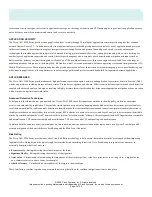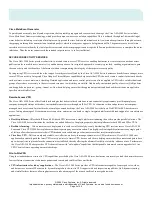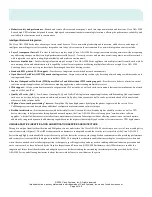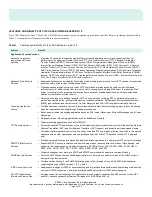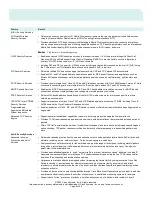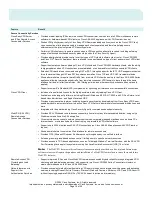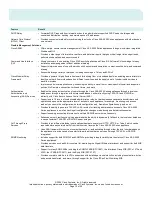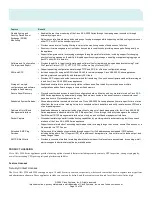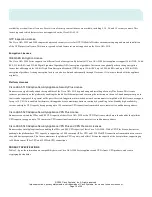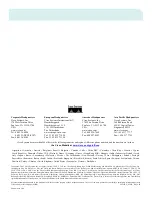
© 2005 Cisco Systems, Inc. All rights reserved.
Important notices, privacy statements, and trademarks of Cisco Systems, Inc. can be found on cisco.com.
Page 14 of 20
Feature
Benefit
Flexible Syslog and
Security Device Event
Exchange (SDEE)
Monitoring
•
Enables the real time monitoring of the Cisco ASA 5500 Series through the management console or through
external syslog servers
•
Delivers accurate time stamping and numbering of syslog messages while supporting multiple syslog servers over
either TCP or UDP as the transport protocol
•
Provides seven levels of syslog filtering to cater to the monitoring needs of businesses of all sizes
•
Ensures critical messages are not lost under busy network conditions by providing message buffering locally on
the appliance
•
Supports fine-grain control over syslog messages through a variety of methods, including support for changing
priority of syslog messages, the ability to disable specific syslog messages, enabling or suppressing logging on a
per-ACL entry (ACE) basis, etc.
Software and Configuration
File Import and Export
•
Provides the ability to import configuration and software files for rapid provisioning and deployment using Trivial
File Transfer Protocol (TFTP), HTTP, HTTPS, or Secure Copy Protocol (SCP)
•
Supports exporting configuration data through TFTP and SCP for off-device configuration storage
SSH and SCP
•
Includes support for using both SSHv1 and SSHv2 to remotely manage Cisco ASA 5500 Series appliances,
providing improved compatibility with third-party SSH tools
•
Provides SCP support as another secure method for transferring files, such as configuration and software images,
to and from Cisco ASA 5500 Series appliances
Storage of multiple
configurations and software
images in flash memory
•
Enables administrators to perform configuration rollback and offers the ability to store and use multiple
configurations and software images in compact flash memory
Secure Asset Recovery
•
Prevents unauthorized access to sensitive configuration data, certificates, and key material stored on Cisco ASA
5500 Series appliances by automatically wiping flash memory contents if an asset recovery or password reset
procedure occurs (if preconfigured to do so)
Scheduled System Reloads
•
Allows administrators to schedule a reload on a Cisco ASA 5500 Series appliance either at a specific time or at an
offset from the current time, making it simpler to schedule network downtime and notify remote-access VPN users
of an impending reboot
Dedicated Out-of-Band
Management Interface
•
Enables businesses to implement the best practice of using out-of-band management for their Cisco ASA 5500
Series appliances, as described in the SAFE Blueprint from Cisco, through the ability to designate the onboard
Fast Ethernet 10/100 management interface to act only as an out-of-band management interface
Packet Capture
•
Gives administrators powerful troubleshooting capabilities by providing robust packet-capturing facilities on each
interface of the Cisco ASA 5500 Series appliance
•
Supports several methods of accessing captured packets, including through the console, secure Web access, or a
file exported to a TFTP server
Extended ICMP Ping
Services
•
Delivers useful troubleshooting methods through support for IPv6 addresses and extended ICMP options,
including data pattern, Don't Fragment (DF) bit, repeat count, datagram size, timeout interval, verbose output, and
sweep range of sizes
SMTP E-Mail Alerts
•
Provides a convenient method for alerting administrators when critical events are encountered, by sending e-mail
alert messages to administrator defined e-mail addresses
PRODUCT LICENSING
Cisco ASA 5500 Series appliances provide licensing options to enable features including security contexts, GTP inspection, strong cryptography,
as well as increasing VPN peer capacity and platform capabilities.
Feature Licenses
Security Context Licenses
The Cisco ASA 5520 and 5540 can support up to 10 and 50 security contexts, respectively, where each context has its own separate security policies
and administrative domain. These appliances include two contexts by default, and those contexts can be used for either Active/Active high


